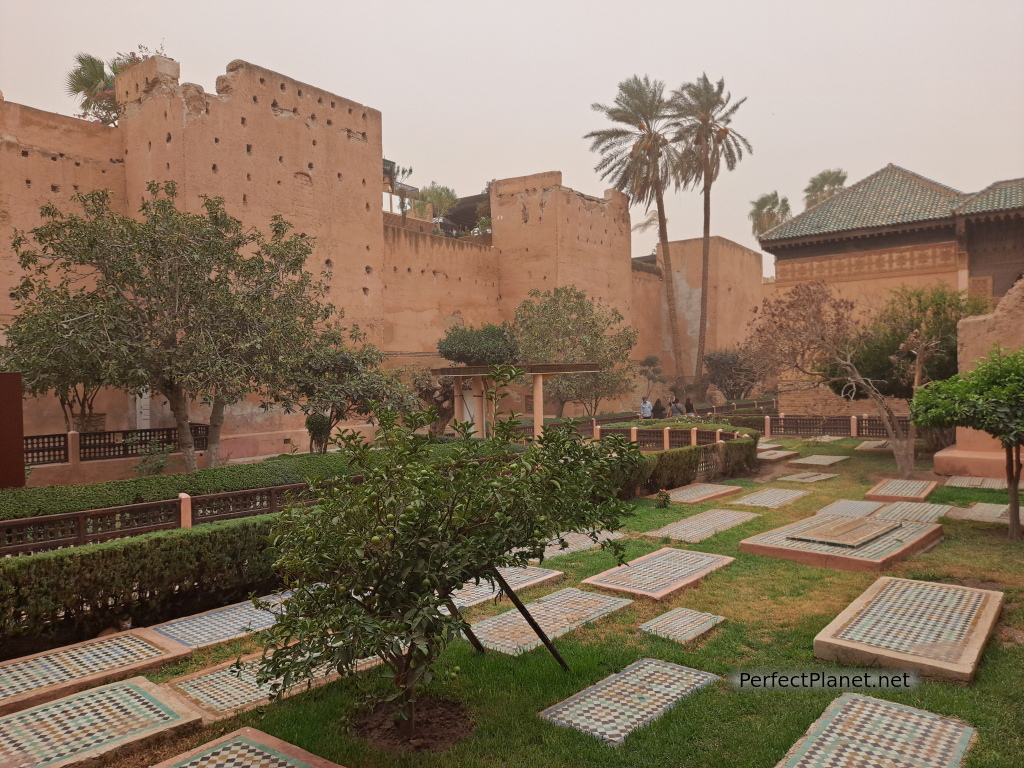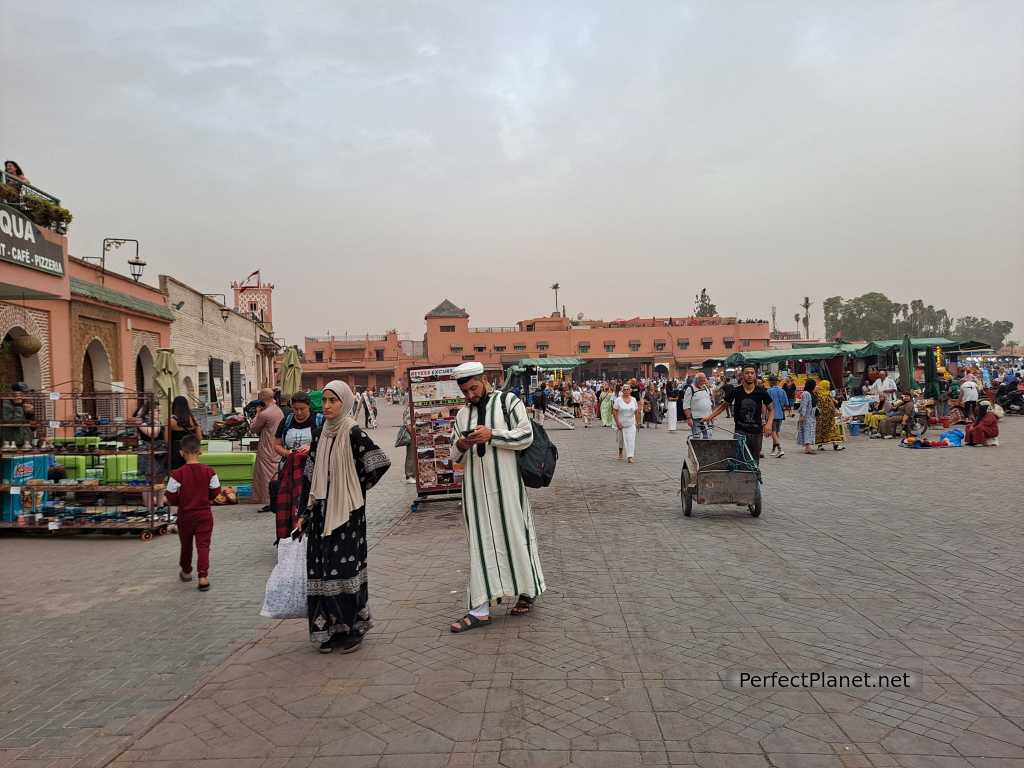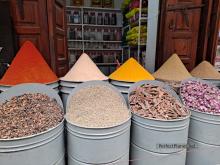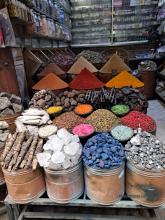Our journey begins in our hometown, Burgos. If you don't know it you have to come and visit it, it's a great plan for a weekend.

Morocco
We leave around 7.30 am towards Seve Ballesteros Airport in Santander, a small airport where it is very easy to move around.
We arrive in Santander by private car but if you decide to arrive in the Cantabrian capital by bus, the S4 bus line connects the Santander bus station with the airport every day from 7.30 am to 22.40 pm, you can check timetables here.
Our flight leaves at 11.35 am, in two and a half hours we arrive in Marrakech without complications. On the flight we meet Jaime, a Moroccan who lives in the village where Joaquín works, and in less than ten minutes he offers us his house to enjoy a week's holiday completely free of charge. The kindness of these people is incredible!
At Marrakech-Menara airport it takes a long time to get through security. We pick up our backpacks and buy a phone card from the Maroc Telecom company, which costs 20€ for 20 gb (you can pay in euros and they give you back the change in euros).

Menara Airport
Our accommodation has offered us a taxi service for the same price as if you ask for an official one at the airport itself, 15€. There is a queue outside the terminal at a booth to the right of the arrivals gate.
The cheapest way to get to the centre of Marrakech from the airport is by bus. An Alsa bus (bus number 19) makes several stops, one of them at Jemaa el-Fnaa square, and costs 3 euros. We are very loaded and decided to go by taxi.

Souk
The taxi leaves us on El Moustachfa street next to an underground pay car park, it cannot enter the medina and brings us as close as possible. He stops a young man to help us find our accommodation, and we give him a coin to thank him.
We stayed at Riad Tamazouzt, in the middle of the Medina, just 5 minutes from the most famous square of Marrakech Jemaa el-Fnaa. It is a basic accommodation with en-suite bathroom and breakfast is included (33,80 € 2pax/day). It is located in a quiet alley with easy access, has a central courtyard and a small roof terrace as common areas.
We rest for a few minutes and spend the afternoon taking the pulse of the city. First visit, the Saadi Tombs. On the way a desert sandstorm accompanies us.

Saadid Tombs
The Saadid Tombs are a mausoleum located in a walled garden. They date from the 16th century. Sultan Ahmad Al-Mansur and his family are buried in the main room. The rich decoration of the rooms, especially the twelve columns, is remarkable.
Outside are buried servants, warriors and governors important to the Sa'did dynasty. Admission 10 €/pax.

Saadid Tombs
Next to the Tombs is the wall of Marrakech, one of the largest and best preserved in Morocco. You can visit the Bab Agnaou gate, a monumental gateway to the city.

Bab Agnaou
Next stop El Badi Palace, also built by Sultan Ahmad Al-Mansur but in this case to commemorate the victory over the Portuguese in the Battle of the Three Kings. It was sacked at the end of the 17th century when Mulay Ismail moved the capital from Marrakesh to Meknes. It is currently being restored, but if you have time it is well worth a visit. In the lower part there is a photographic exhibition that leads to a very curious old columned room. The minbar or pulpit of the Koutoubia Mosque is exhibited in this palace, but we were unable to see it because it was under restoration. Admission 10€/pax.

El Badi Palace
Next to the El Badi Palace is the Jewish quarter or Mellah and the spice square of Marrakech. We went to the cemetery or Miaara, but as it was closed on Saturday.
On 8 September 2023, a 6.8 magnitude earthquake occurred in southern Morocco. The epicentre was located in the Atlas Mountains but also affected Marrakech. Many of the buildings in Marrakech are shored up, including the Jewish quarter which bore the brunt of the quake. Many houses collapsed and many people now live there without resources. Jewish families no longer live in the Mellah, they either emigrated to Israel or moved to Gueliz, a new and modern neighbourhood for the most elite part of the city.

Mellah souk
The Mellah of Marrakesh dates back to the 16th century and was created to protect the Jewish population from Muslim attacks and to control the collection of taxes. You can still visit the Salat Alzama Synagogue (only open for prayer on Saturdays) and the covered souk or Kyssaria, located next to the spice souk.

Mellah souk
It's well worth taking a stroll through the Jewish quarter and getting lost in its labyrinthine streets.
The spice souk, next to the Mellah, is a market that awakens all your senses. Colours and smells that will not leave you indifferent and allow you to get to know a little more about the importance Morocco has always had in its trade routes with East and South Africa.

Spice souk
Next to the spice souk is the spice square, much less crowded than other squares in the city, where we enjoyed our first Moroccan mint tea. If you like it unsweetened, ask for it beforehand as they tend to make it very sugary.

Spice square
On the way to the most popular square in Marrakech, Jemaa el-Fnaa, we enjoy the maze of labyrinthine streets full of shops inside the medina. Even though they are very narrow, they have a lot of traffic, motorbikes, bikes, donkeys, carts, you have to be careful not to get run over.
Jemaa el-Fnaa Square is the central square and the most important place in the Medina. During the day and at night it's crazy. You can find everything from snake charmers, monkey tamers, juice stalls to henna tattoo artists. When night falls there are musicians, dancers and popular games in which you can take part. There are also typical Moroccan food stalls where you can try the delicious harira (Moroccan soup), meat and fish kebabs and even boiled snails.

Jemaa el - Fnaa
Tonight we decided to have dinner at the only cheap restaurant we could find in the locals, it's called Snack Toubkal and you can have lunch or dinner for two people for around 10€ each. The food is really good, especially the lemon chicken tajine with olives and the lamb with plums. One chicken and one vegetable tajine and a yoghurt for 86dh.
From what we have been told Marrakech prices have risen quite a lot since the Covid (in all Morocco), almost all restaurants offer menus from 80dh/pax without drink.
In general Marrakech is surprising us by the cleanliness of the streets (if hundreds of cats) and the lack of strong smells (they put carpets in the exits of the sewers), a modern and open city to the traveller.

Jemaa el - Fnaa
Tip. If you don't have much time in Marrakech, the must-see sights in Marrakech are the Jemaa el-Fnaa square, the Medersa Ben Youssef, the Bahia Palace and the Saadian Tombs. Remember that everything closes at 5 pm.
Flight from Santander to Marrakech Ryanair 2 pax with two checked bags 190€.
Taxi from the airport to our accommodation 15€/trip
Accommodation Riad Tamazouzt, double room with bathroom and breakfast 33,80€ 2pax
1,5 litre water in a shop 7dh
Entrance to Saadi Tombs 10€/pax
Entrance to El Badi Palace 10€/pax
Dinner at Snack Toubkal restaurant, two tajines and one large bottle of water 86dh
Map
- Log in to post comments







